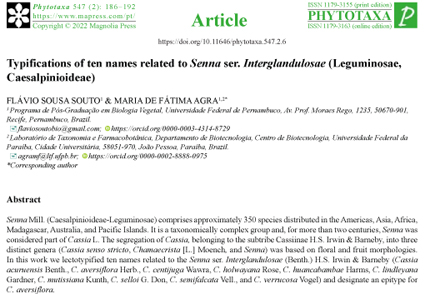Abstract
Senna Mill. (Caesalpinioideae-Leguminosae) comprises approximately 350 species distributed in the Americas, Asia, Africa, Madagascar, Australia, and Pacific Islands. It is a taxonomically complex group and, for more than two centuries, Senna was considered part of Cassia L. The segregation of Cassia, belonging to the subtribe Cassiinae H.S. Irwin & Barneby, into three distinct genera (Cassia senso stricto, Chamaecrista [L.] Moench, and Senna) was based on floral and fruit morphologies. In this work we lectotypified ten names related to the Senna ser. Interglandulosae (Benth.) H.S. Irwin & Barneby (Cassia acuruensis Benth., C. aversiflora Herb., C. centijuga Wawra, C. holwayana Rose, C. huancabambae Harms, C. lindleyana Gardner, C. mutissiana Kunth, C. selloi G. Don, C. semifalcata Vell., and C. verrucosa Vogel) and designate an epitype for C. aversiflora.
References
Bentham, G. (1871) Revision of the genus Cassia. Transactions of the Linnean Society of London 27: 503–591. https://doi.org/10.1111/j.1096-3642.1871.tb00220.x
Colladon, L.T.F. (1816) Histoire naturelle et médicale des Casses, et particulièrement de la Casse et des Sénés employés en médecine. Jean Martel, Montpellier, 160 pp.
De Candolle, A.P. (1825) Prodromus Sistematic Naturalis Regne Vegetabilis, vol. 2, Venitique in eorumdem bibliopoliis Argentorati et Londini, Paris, 644 pp.
Hayez, M. (1843) Bulletins de l’Académie royale des sciences, des lettres et des beaux-arts de Belgique, t. X, p. II. L’Académie royale, Bruxelles, 582 pp.
Hiepko, P. (1987) The collections of the Botanical Museum Berlin-Dahlem (B) and their history. Englera 7: 219–252.
Hooker, W.J., Vogel, T., Webb, P.B., Hooker, J.D. & Bentham, G. (1849) Niger flora: or, An enumeration of the plants of western tropical Africa, vol. 1. H. Bailliere, London. 650 pp.
Irwin, H.S. & Barneby, R.C. (1982) The American Cassiinae: A synoptical revision of Leguminosae tribe Cassieae subtribe Cassiinae in the New World. Memoirs of the New York Botanical Garden 35: 1–454.
Linnaeus, C. (1753) Species Plantarum. Laurentii Salvii, Stockholm. 560 pp.
Marazzi, B., Endress, P.K., Queiroz, L.P. & Conti, E. (2006) Phylogenetic relationships within Senna (Leguminosae, Cassinae) based on three chloroplast DNA regions: Patterns in the evolution of floral symmetry and extrafloral nectaries. American Journal of Botany 93: 288–303. https://doi.org/10.3732/ajb.93.2.288
Marazzi, B., Conti, E. & Endress, P.K. (2007) Diversity in anthers and stigmas in the buzz-pollinated genus Senna (Leguminosae, Cassiinae). International Journal of Plant Science 168: 371–391. https://doi.org/10.1086/512105
Miller, P. (1754) The Gardeners Dictionary, vol. 3, ed. 4, Printed for the Author and Sold by John and James Rivington, London, without pagination.
Miller, H.H. (1970) The herbarium of Aylmer Bourke Lambert notes on its acquisition, dispersal, and present whereabouts. Taxon 19: 489–553. https://doi.org/10.2307/1218947
Moench, C. (1794) Methodus Plantas Horti Botanici et Agri Marburgensis. Officina nova libraria academiae, Marburgi Cattorum, 368 pp.
Ostermeyer, F. (1907–1908) Plantae Peckoltianae. Annalen des Naturhistorischen Museums in Wien 22: 129–142.
Person, C.H. (1805) Synopsis plantarum. Ch. Fr. Gramer, Parisiis Lutetiorum, 546 pp.
Prado, J., Hirai, R.Y. & Moran, R.C. (2015) (046–048) Proposals concerning inadvertent lectotypifications (and neotypifications). Taxon 64: 651–651. https://doi.org/10.12705/643.29
Randell, B.R. (1988) Revision of the Cassiinae in Australia. 1. Senna Miller sect. Chamaefistula (Colladon) Irwin and Barneby. Journal of the Adelaide Botanic Garden 11: 19–49.
Randell, B.R. (1989) Revision of the Cassiinae in Australia. 2. Senna Miller sect. Psilorhegma (J. Vogel) Irwin and Barneby. Journal of the Adelaide Botanic Garden 12: 165–272.
Randell, B.R. (1990) Revision of the Cassiinae in Australia. 3. Senna Miller sect. Senna. Journal of the Adelaide Botanic Garden 12: 165–272.
Randell, B.R. & Barlow, B.A. (1998) Senna: Flora of Australia 12: 89–138. https://doi.org/10.1177/1329878X9808900114
Rose, J.N. (1905) Studies of Mexican and Central American plants—No. 4. In: Cook, R & Maxon, C. (Eds.) Contributions from the United States National Herbarium, v. 8, n. 4. Government printing office, Washington, pp. 281–339. [https://www.jstor.org/stable/23490910]
Sims, J. (1826) Curtis’s botanical magazine, or, Flower-garden displayed, vol. 53. Academic Press, London. No paging.
Singh, V. (2001) Monograph on Indian subtribe Cassiinae (Caesalpiniaceae). Scientific Editions, Jodhpur, 278 pp.
Turland, N.J., Wiersema, J.H., Barrie, F.R., Greuter, W., Hawksworth, D.L., Herendeen, P.S., Knapp, S., Kusber, W.-H., Marhold, D.-Z.Li.K., May, T.W., McNeill, J., Monro, A.M., Prado, J., Price, M.J. & Smith, G.F. (2018) International Code of Nomenclature for algae, fungi, and plants (Shenzhen Code) adopted by the Nineteenth International Botanical Congress Shenzhen, China, July 2017. Regnum Vegetabile 159. Glash ¨utten: Koeltz Botanical Books. https://doi.org/10.12705/Code.2018
Thiers, B. (2021) Index Herbariorum: a global directory of public herbaria and associated staff. New York Botanical Garden’s Virtual Herbarium, New York. Available from: http://sweetgum.nybg.org/ih/ (accessed 25 July 2021).
Vellozo, J.M.C. (1829) Florae fluminensis, seu, Descriptionum plantarum praefectura Fluminensi sponte mascentium liber primus ad systema sexuale concinnatus. Typographia nationali, Flumine Januario. 352 pp. https://doi.org/10.5962/bhl.title.745
Vogel, T. (1837) Synopsis Generis Cassiae. Typis Nietackianis, Berlin, 79 pp.


